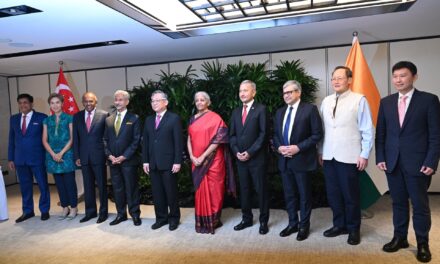Singapore’s private sector saw a sharp improvement in business conditions in August amid strong inflows of new business and high economic activity.
“Singapore’s private sector expansion remained robust in August, with the rate of expansion having accelerated for a fourth successive month to signal that the upturn continued midway through the third quarter of the year,” said Jingyi Pan, an economics associate director at S&P Global Market Intelligence, on Thursday in a note.
The headline seasonally adjusted S&P Global Singapore Purchasing Manager’s Index – a composite single figure indicator of performance – came in at 57.6 in August, up from 57.2 in July. Any reading above 50.0 indicates sector expansion.
Singapore’s private sector shows strength in August
This was the 18th successive monthly improvement of business conditions in the Singapore private sector.
“Barring any sharp downturns in September, the latest whole economy PMI suggests that we will see a better third quarter GDP,” said Pan.
The rate of growth in Singapore’s private sector was the highest since October 2022.
Subsequently, higher purchasing levels and recruitment were seen in August.
“Rising new work intakes led to a further accumulation of backlogged work in the Singaporean private sector, with the volume of unfinished business increasing at the fastest pace in three months. In turn, firms took on additional staff to cope with the build-up of capacity pressure,” S&P Global said in Thursday’s note.
The Real Estate & Business Services sector proved to be the darling of the month as it saw the sharpest rise in both new business inflows and activity out of all the sectors.
Headwinds
The stellar performance was not without its worries though. Shipping, supply and labor constraints hit vendor performance. Lead times were the worst in 18 months.
Vendor performance refers to how effectively suppliers (vendors) deliver goods and services to businesses. It encompasses factors like delivery speed, quality of goods, reliability, and adherence to agreements.
Lead times are the amount of time between placing an order with a vendor and receiving the goods or services. Longer lead times suggest slower deliveries.
Turning to inflation, cost burdens continued to rise due higher transport costs and rising input material prices. Inflation was further fanned by wage increases.
“The construction sector observed the quickest rise in both input costs and charges among the monitored sectors,” S&P Global said.
“Despite the worsening of supply conditions and price pressures, Singaporean private sector firms maintained a positive outlook for business activity in the year ahead. The level of optimism soared to the highest in just over three years with hopes that business conditions can improve and support sales.”
Data
The S&P Global Singapore PMI is compiled by S&P Global from responses to questionnaires sent to purchasing managers in a panel of around 400 private sector companies. The panel is stratified by detailed sector and company workforce size, based on contributions to GDP. The sectors covered by the survey include manufacturing, construction, wholesale, retail and services.
Survey responses are collected in the second half of each month.







